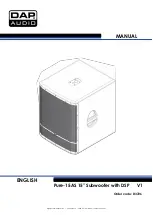
Page 9
7. A Tour of the SUB 15
Universal Amplifier
and I/O
1.
LEFT / RIGHT XLR IN
- These XLR inputs should be connected to
the left / right output of your console or digital workstation. The
inputs are electronically balanced. Do not connect more than
one source to these inputs. Refer to page 6 for more information
[System Signal Connection].
2.
LEFT / RIGHT XLR OUT
- These XLR outputs should be connected
to the inputs of your left / right nearfield or mid-field monitors. The
outputs are electronically balanced. [System Signal Connection].
3.
UNIVERSAL / BLUE SKY FILTER SWITCH
- This switch is used to
either activate the variable state filters, or activate the fixed 80Hz
low pass and high pass filters that are required for use with Blue
Sky monitors. If you are using the SUB 15 Universal with the SAT 5,
you will also need to set the 80Hz High Pass Filter on the SAT 5 so
that it is “OUT” of circuit.
4.
VARIABLE CUTOFF FREQUENCY CONTROL KNOBS -
These
controls are for adjusting the dual 24dB per octave low and high-
pass filters. The cutoff frequency can be adjusted from 50Hz to
160Hz. It is recommended that the SUB 15 Universal’s filters be
set one octave above the natural roll off of the nearfield monitors
that are being used with the SUB 15 Universal. To activate these
variable filters, the UNIVERSAL / BLUE SKY SWITCH - must be in the
up position (VARIABLE). For more information see item 10 on page
5 [Quick Setup].
5.
VOLTAGE SELECTOR SWITCH-
This switch can be set to either 115
Volts or 230 volts. Prior to powering this unit, please confirm that
the Voltage selector switch, located on the back of the subwoofer,
has been set to the correct voltage setting. If you are unsure of
the type of power that is supplied to your home / studio, consult
your product dealer or local power company. If your changing
the Voltage, please also confirm the proper fuse is installed [see
number 6].
6.
POWER SWITCH -
Controls the power to the amplifier and all
internal electronics.
7.
FUSE HOLDER / IEC RECEPTACLE
-
Replace with same rating and
type for your local voltage rating. For 115V applications use a 15
Amp T 250V and for 230 Volt applications use a 8 Amp T 250V
fuse. Check voltage selector switch before connecting power (T
stands for time delay or SloBlo). Connect to 115 Volt AC / 60Hz
power source, rated for 1600 WATTS or 230 Volt / 50Hz rated
for 1600 WATTS. Only use the supplied power cord or an IEC
approved power cord with a safety ground pin.
8.
AMPLIFIER HEATSINK-
The heatsink provides essential cooling to
the amplifier inside the SUB 15 Universal. Please ensure that proper
air circulation is available for proper cooling.
9.
SUB GAIN -
This knob controls the input sensitivity of the
subwoofer amplifier only. When set to the reference position a
100mV signal at the input equals 90dB output at a meter.
10.
LF Extension -
One of the SUB 15 Universal’s unique features is a
switchable low frequency response characteristic, of either 30Hz
to 200Hz +/-3dB or, in “extended LF mode”, 20Hz to 200Hz +/-3dB
(anechoic), marked 30Hz and 20Hz respectively. The extended
mode is ideal for large rooms that don’t exhibit the room gain
phenomenon of smaller sealed spaces. The only way to be
absolutely sure of which setting is appropriate for your studio is to
use an acoustic analyzer. Using the 20Hz in a sealed space, such
as a small to medium size studio, can result in a rising LF response
characteristic below 30Hz.
13.
PHASE -
This switch is used to change the phase response of the
subwoofer only. When this switch is in the 0 position, it is in-phase
with the signal going to the nearfield or mid-field monitors. When
this switch is in the position marked 180, it is 180 degrees out-of-
phase with the signal going to the nearfield or mid-field monitors.
The PHASE setting on the SUB 15 Universal should typically be set
to 0, especially when the SUB 15 Universal is used with Blue Sky
SATs. However, there may be times, depending on the speakers
used with the SUB 15 Universal or because of certain acoustic
conditions, that the phase setting needs to be set to 180, so as to
get proper summation between SAT and SUB. The only way to be
absolutely sure which setting is appropriate for your studio is to use
an acoustic analyzer.
13.
AUTO POWER -
This switch is used to activate the automatic mute
circuit built into the subwoofer. When the automatic mute circuit is
activated, the system will automatically mute both the subwoofer
and satellite outputs when no signal is present for 15 minutes. This
mode also reduces power consumption at idle. Once a signal is
present again, the system will automatically turn on.
13.
SUB OUT-
This balanced XLR output can feed additional
subwoofers for increased bass performance and should be
connected to the SUB IN of an additional Blue Sky 15. The output
contains the summed low passed subwoofer output and the SUB
IN audio.
14.
SUB IN -
This XLR input can be connected to either the subwoofer
output of an external bass-management controller, or the “daisy-
chain” output of a SUB 15 Universal. This input is full-bandwidth
(up to approximately 200Hz) and does not use a low pass filter.


































